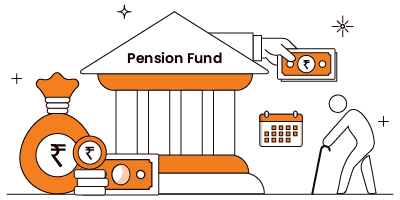What are pension funds?
Pension funds or retirement funds are saving schemes wherein you invest a small portion of your income in a specific and pension designated fund. The sole objective of this fund is to generate income for you when you retire and in need of your pension.
What is a Pension Plan?
Pension Plan or Retirement Plan is a kind of fund to which a specific amount of money from your pay is invested during the tenure of your employment. This investment further helps in drawing payments during the retirement period. A Pension Plan is also known as a benefit plan. As the name suggests the investments now lead to benefit in the future and are ideal for financially securing senior citizens.
A fixed investment now into a Pension Plan makes the future financially secured. Moreover, these investments help one achieve financial securities and overcome any other uncertainties that may evolve in the future.
With the increasing cost of living and rising inflation, it has become all the more important to invest in a good Pension Plan. This will not only lead to future financial security but also help one lead a happy life without compromising the living standards.
Pension Plans sometimes also come with insurance cover. These plans are usually Long Term Plans. Investments in these Plans can be made either monthly or quarterly. All you have to do is pay an amount regularly over a fixed period of time and enjoy the benefits after you retire.
Stages of Pension Funds
Pension funds consist of 2 stages i.e. accumulation stage and the retirement stage. In the accumulation stage, you invest your income in the pension fund till you retire. Whereas in the retirement stage or the vesting stage you start receiving your annuities until death
Categories of Pension Funds
- The funds that are sponsored by insurance companies wherein the corpus is invested in debt funds and better suited for conservative investors
- Unit Linked Plans wherein the funds are invested in both equities and debt. Further, this category allows the investors to create a balanced portfolio with its balanced approach
- National Savings Scheme is the government sponsored fund. Here the funds are either debt securities or government securities.
Types of Pension Plans in India
Investing in a good Pension Plan as per your financial goal is the first criteria one must follow. There are several Pension Plans available in India which gives you varied benefits. Choosing the right plan is the first step towards a secure future.
There are a wide variety of Plans available in the market. Each plan has a specific classification with regard to its structure and benefits. All Pension Plans have a divergent benefit structure. The following are the different types of Pension Funds available in India-
1. Deferred Annuity
Annuities have been popular as they offer guaranteed income. People are looking for smarter ways to invest and manage their retirement savings. These are a kind of insurance plan for long term savings.
A Deferred Annuity option requires an investor to build a corpus. He/ she can use this corpus later to buy an annuity at the time of retirement. The Life Insurance Company promises to pay the insurer a regular or lump-sum amount at the future maturity date. Further, you can purchase annuities by a one-time payment method or through a regular premium payment method. These also have the benefit of tax exemption up to a limit like any other insurance plan.
There are several different types of Deferred Annuity- Fixed, Indexed, and Variable which further determines the rate of return. As the name suggests, Fixed Annuity promises a guaranteed or fixed rate of return, Index Annuity the return is based on the market index, and Variable Annuity is based solely on the portfolio of the Mutual Fund performance or other accounts so chosen by the owner.
Deferred Annuities are fixed or locked and are subject to charges at the time of early withdrawal. In case you withdraw before the maturity date, tax penalties of 10% is applicable
2. Immediate Annuity
Immediate Annuity is also a kind of life insurance premium pension plan that promises to pay a series of annuity payments throughout your life. You also have an option of a joint-life pension annuity plan. Here the annuity payments are available even during the lifetime of your spouse.
The purchase price of the annuity is payable in a single premium. The annuity payment frequency can be monthly, half-yearly, quarterly, or annually as per the choice of the Annuitant. These annuities offer guaranteed income almost immediately. The premium is tax-exempt as per the Income Tax Act 1961.
3. Certain Annuity
A Certain Annuity is offered by an Insurance Company limited. These are an investment in retirement income. A Certain Annuity option provides a guaranteed retirement income for a pre-specified period to the Annuitant or his nominees. You can also opt for a lump sum annuity payment.
Due to its set expiration date, these annuities provide higher returns than any other annuity option. These have high upfront fees and other charges as compared to other traditional annuities.
4. With Cover and Without Cover Pension Plans
Pension Plans with cover means the life of the Policy Holder is covered and upon his death, a lump sum amount is paid to his immediate family members also known as the nominees. These plans are like the typical insurance plan but the amount paid under these plans is not considerable. The large amount invested in these plans goes to the building of the corpus rather than covering the life risk.
Pension Plans without Cover are those plans where the life of the Policy Holder is not covered. Upon the death of the Policy Holder, the nominee only gets the corpus so built during his lifetime. Only Long Term insurance plans have the option of life cover like Deferred Annuity Scheme, unlike Immediate Annuity which is short term and does not cover life.
5. Guaranteed Period Annuity
As the name suggests a Guaranteed Period Annuity is an annuity that offers guaranteed returns. This annuity ensures that the immediate family members of the Annuitant are benefitted even after the death of the Policy Holder throughout the entire period of guarantee of the annuity.
6. Life Annuity
Life Annuity is the most common type of Pension Plan. Under this plan, a Policy Holder or Annuitant is guaranteed a life pension annuity income throughout his life. It also provides the option of Joint-Annuity where the annuity is paid to the spouse even after the death of the Policy Holder.
7. Life ULIP Plan
Life ULIP Plan or Unit Linked Investment Plan is a single integrated plan where unlike a traditional insurance plan both life cover and investment are provided. These are offered by Insurance Companies.
A portion of the investment made under these plans is utilized to provide life cover and the remaining is invested in Equity and Debt Funds. There are certain charges levied on these schemes, unlike the traditional Insurance Policies.
However, the returns under the Unit Linked Insurance Plan depends entirely on the market conditions and the risk of investment is solely borne by the PolicyHolder.
8. Defined Benefit Pension Plan
A Defined Benefit Pension Plan is one where a specified pension payment, lump-sum, or combination thereof is paid to the employee by his employer. These are employer-sponsored retirement plans. The benefit of an employee is computed taking into account his age, earnings, tenure of service, etc.
The incomes under this plan are generated solely on the basis of your work. It is a joint contribution of both you and your employer that makes retirement much easier.
9. Defined Contribution Pension Plan
Defined Contribution Pension Plan requires one to contribute their own money towards a retirement plan. Here both the employer and the employee make contributions on a regular basis.
Accounts are set up for each individual and benefits are calculated as per the credits held in these accounts through both employee and employer contribution. A predetermined portion of the employee’s income goes towards these accounts as his contribution and the rest is matched by the employer. This contribution can later be used as retirement benefits by an employee.
10. National Pension Scheme (NPS)
One of the most significant steps taken by the Government of India was the introduction of the National Pension Scheme (NPS). Though the Scheme was initially applicable to Government Employees only later the same was opened for all the citizens of India in 2009.
This Scheme was introduced to safeguard the retirement benefits of the individual post retirement. Due to its tax savings benefit, NPS has become a popular investment scheme in recent times. These are managed by the Pension Fund Regulatory And Development Authority.
Under this Scheme, only 60% of the fund is withdrawable on retirement. The rest of the 40% fund is further utilized in purchasing annuities.
11. Pension Funds
Pension Funds are another type of Retirement Pension Plan which are popular among investors. These Funds usually have a large amount of money invested and the returns are higher as compared to the other retirement plans.
Comparison Between Pension Plans or Pension Funds
Choosing the right plan as per the needs and financial goals can be a difficult but critical decision. The right decision made now benefits one in the future. Likewise, a smart decision made now will lead to a better life post retirement. Hence, it becomes very important to select the best pension fund so as to secure your financial needs during old age.
A comparison between the different Pension Plans will give a better understanding of these plans and further assist in making the right choice.
| Retirement Plans | Tax on Income | Applicable Tax on Investment | Tax on withdrawal | Withdrawal Flexibility | Flexibility of Increase & Decrease Income | Lock-in Periods |
| Deferred Annuity | Taxable | Tax-free | 1/3rd non-taxable 2/3rd taxable | After expiry of 1 year 10% of the annuity value can be withdrawn | No | Up to 10 years |
| Immediate Annuity | Applicable Income Tax rate | Exempted | 2/3rd taxable 1/3rd non-taxable | Post expiry of 1 year 10% of the annuity value can be withdrawn. | No | Up to 15 years |
| Certain Annuity | Under the Income Tax rate | Non-taxable | Taxed as Capital Gains | 33% of fund value upon retirement | No | 5 years, 10 years and 15 years |
| With and Without Cover Pension Plans | Taxed | No Tax | 1/3rd non-taxable 2/3rd taxable | up to 33% upon retirement | No | 5 years |
| Guaranteed Period Annuity | Taxable | Tax-Free | 1/3rd non-taxable 2/3rd taxable | Up to 33% of fund value upon retirement | No | Stops on death of annuitant |
| Life Annuity | Taxed | Exempt | 1/3rd non-taxable 2/3rd taxable | Withdrawal up to 33% of fund value upon retirement | No | 15 years |
| Life ULIP Plan | Exempt | u/s 80C up to 1.5 lakhs | Yes. 100% withdrawal tax-free | 100% withdrawal anytime after 5 years | Yes | 5 years |
| Defined Contribution Pension Plan | Taxed | Tax-Free | No.Withdrawal up to 33% on retirement | Up to 33% of Fund value on retirement | No | Depends on type of pension fund |
| National Pension Scheme (NPS) | Yes | Tax deductions u/s 80 CCD(1B) upto 50K and section 80C upto 1.5 lakh | Upto 60% of the fund value tax free upon retirement | No. Partial withdrawal upto 25% after 10 years | No | Can be withdrawn at the age of 60 |
| Pension Fund | Taxed | Yes | No. Partial withdrawal upto 50% | Partial withdrawal upto 50% | No | Depends upon type of pension fund |
Features of pension funds in India
Here we will discuss the prominent features of the Pension Plan available in India.
- Guaranteed Monthly Income: Most of the Pension Plan offers a fixed income upon your retirement. Plans like Immediate Annuity allows you to receive monthly or annual income as soon as you invest. The pension can be paid either for a fixed period of time or until death. The same depends solely on the type of plan you choose.
- Tax Benefits: The most important feature of a Pension plan is its tax savings nature. Many such plans give a tax exemption of 10% to 40% under section 80C of the Income Act. Tax exemption depends on the plan you choose. It is always advisable to start planning your retirement early so as to reap maximum tax benefits.
- Vesting Age: Vesting age is where you start receiving a monthly Pension. The minimum vesting age in most plans is 40 to 50 years and the maximum vesting age is up to 75 years. Between the vesting age, one can decide at which age you would want to start receiving a pension.
- Surrender Value: Every Plan has a maturity date. It is very important to wait for the plan you have purchased to complete its maturity date so you get the maximum benefit out of it. There are times when you still want to surrender due to some unforeseen emergencies, the same can be done and you would still receive the surrender value of the same provided the plan has crossed the minimum duration. This feature is only available in Pension plans that include life insurance plan benefits.
Check Out Best Retirement Plans





























Show comments